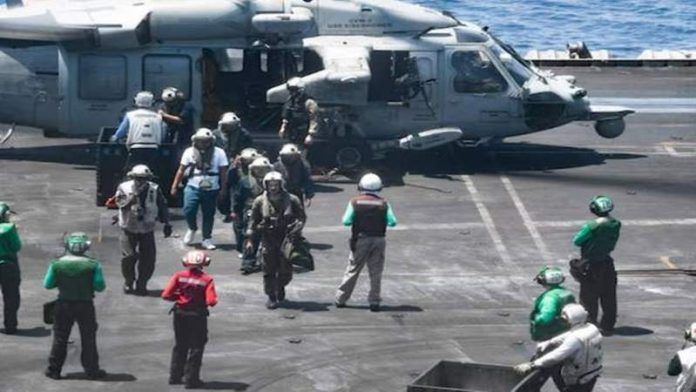US media outlets have increasingly reported on the setbacks and failures faced by the US Navy in the Red Sea, particularly focusing on the struggles of the aircraft carrier Eisenhower.
The Aviationist, a military site, reported that Eisenhower was overwhelmed by a series of drone, fast attack boat, and cruise missile attacks. The crew reportedly experienced severe fatigue due to the unexpected and persistent Yemeni assaults. The intensity of these attacks even led to a missile shortage on the destroyers within the carrier strike group, necessitating resupply from nearby stations. The German frigate Hessen also depleted its arsenal while attempting to fend off Yemeni operations.
Earlier this month, The Telegraph noted that these attacks have not only increased but also diversified in their methods. Recognizing its inability to control the situation in the Red Sea, the United States withdrew all its warships, followed by the UK, leaving only European ships in the region.
The Telegraph further reported on the failure of “Operation Prosperity Guard,” a US initiative launched in December 2023 to deter Yemeni attacks. Despite the initiation of “Operation Poseidon Archer” in January, involving US and British airstrikes on Yemen, the report compared these efforts to “hitting smoke,” echoing the ineffective Saudi experiences from 2015 to 2023.
The report highlighted that none of these efforts have made significant progress, even as the European Union formed a separate coalition, “Aspids,” to distance itself from US policy toward Israel. The lack of a unified Western approach to the mission has not gone unnoticed by shipping companies, further undermining confidence.
Since January, attacks have increased in frequency and complexity, including the use of drones, cruise missiles, kidnappings, and ballistic missile strikes. April saw the first use of an unmanned surface vessel, with a notable increase in such attacks since then. Recently, Yemeni forces have followed up their attacks with small arms fire from high-speed boats, leading to five attacks every two weeks.
The report also detailed an attack on the Greek oil tanker Sounio for violating a ban on accessing occupied Palestinian ports, with a European Union ship evacuating the crew.
Currently, European military ships are the only ones in the region, as no vessels from the Prosperity Guard operation remain within a 500-mile radius. In May, when the USS Dwight D. Eisenhower was present, the US had 12 warships providing missile surveillance and escort missions. Now, the US has no ships in the area. The UK briefly had three ships, but they too have since departed.
The report continued that this does not mean Americans are not facing their own problems. The US Navy has announced that it may have to stop 17 support ships due to crew-related issues. The western Pacific lacks aircraft carriers for the first time in years. It is a strange paradox that two of these ships are located in the Middle East region, but not in the Red Sea. Additionally, the latest US frigate construction program is collapsing, and the construction rate of Virginia-class submarines is below the required level to maintain the current fleet.
The report suggested that the US has abandoned the Prosperity Guard operation, having failed to deter the Yemenis or reassure maritime shipping, and may now need to focus on other priorities. The passage around the Cape of Good Hope is becoming the new normal, with little confidence that deploying another US carrier, like the Theodore Roosevelt, would guarantee success.
The report concluded that the US is now facing a significant shift in its historical maritime strategy, with its traditional deterrence tactics no longer proving effective.




















